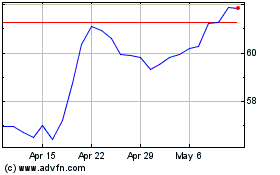Wells Fargo Expects Fed Asset Cap to Continue Into Early 2019 -- 3rd Update
May 10 2018 - 4:57PM
Dow Jones News
By Emily Glazer
Wells Fargo & Co. will remain constrained by a
regulator-imposed limit on growth for longer than expected, its
chief executive said Thursday, as the bank continues to address the
ramifications of risk-management failures.
Citing "widespread consumer abuses," the Federal Reserve in
February imposed an asset cap on Wells Fargo, an unprecedented
enforcement action that threatened to crimp the San Francisco-based
lender's revenue and profit growth.
Wells Fargo said at the time that reviews of its plans related
to the Fed's enforcement action would be completed by October. The
Fed would need to sign off on those plans before the cap is
lifted.
But on Thursday, CEO Timothy Sloan said during Wells Fargo's
investor day presentation that the bank needed more time to address
and incorporate feedback from the Fed, and that the asset cap would
continue into the first part of next year.
Wells Fargo is barred from growing past the $1.95 trillion in
assets it had at the end of 2017 unless it gets regulators'
permission. It can continue to lend and take deposits.
The updates hit Wells Fargo at a difficult time. Analysts and
investors are looking for revenue and business growth to return
while addressing regulatory scrutiny across the firm.
Mr. Sloan said Wells Fargo is having a "constructive dialogue"
with the Fed on its recently submitted plans, but can't disclose
further information due to confidential regulatory discussions.
Despite the delay, Wells Fargo Treasurer Neal Blinde said during
Thursday's investor presentation that Wells Fargo won't have to
take as many actions as it expected related to the Fed's asset cap
since "loan and deposit growth is below previous expectations,"
according to the investor presentation.
The impact on net profit after tax, he said, will likely be less
than $100 million instead of the range of $300 million to $400
million Wells Fargo initially disclosed in February. He also said
that while the asset cap's earnings impact was minimal in the first
quarter, it is expected to "modestly increase" in future
quarters.
Still, investors are growing weary.
Barclays banking analyst Jason Goldberg wrote in a research note
Thursday that while the market may view Wells Fargo's financial
outlook favorably, portfolio managers "keep on telling us they need
to see the negative headlines abate...and revenue growth to
return."
In April, the bank settled with the Office of the Comptroller of
the Currency and the Consumer Financial Protection Bureau for $1
billion over failures to manage risk, causing it to adjust
first-quarter earnings lower by $800 million.
In the first quarter, revenue fell to $21.9 billion, down nearly
2% from a year earlier. Total loans of $947.3 billion declined
compared with the prior and year-earlier quarters. And the bank's
mortgage business, once the largest in the U.S., has shrunk and now
trails Quicken Loans.
Wells Fargo's expenses have also remained high, in part because
of the bank's need to address regulatory and business issues.
Finance Chief John Shrewsberry said the bank is still on track
with its goal of cutting expenses by $4 billion by 2019. He said
Thursday its expense range in 2019 is $52 billion to $53 billion,
which excludes any additional litigation accruals and
penalties.
Mr. Shrewsberry said in January -- when the bank disclosed its
first expense targets -- that its 2018 expenses would likely be
between $53.5 billion and $54.5 billion. Mr. Shrewsberry also said
Wells Fargo's two-year return on equity target was between 12% and
15%. Last year, the closely watched profitability metric stood at
11.4%.
Wells Fargo's consumer-banking division is bearing much of the
expense cuts.
On Thursday, the bank said it would continue to reduce its
branch count, lowering it to 5,000 branches by 2020. Mary Mack,
head of Wells Fargo's consumer bank and consumer lending, said that
would reduce branches by about 1,000 from present.
The closures will yield expense savings of about $500 million
annually, she said. Ms. Mack said the bank expects to have around
5,500 branches by the end of 2018.
Wells Fargo executives also talked about technology investment
and more movement toward digitizing that it hopes will save costs,
retain customers and attract new clients.
Write to Emily Glazer at emily.glazer@wsj.com
(END) Dow Jones Newswires
May 10, 2018 16:42 ET (20:42 GMT)
Copyright (c) 2018 Dow Jones & Company, Inc.
Wells Fargo (NYSE:WFC)
Historical Stock Chart
From Mar 2024 to Apr 2024

Wells Fargo (NYSE:WFC)
Historical Stock Chart
From Apr 2023 to Apr 2024
